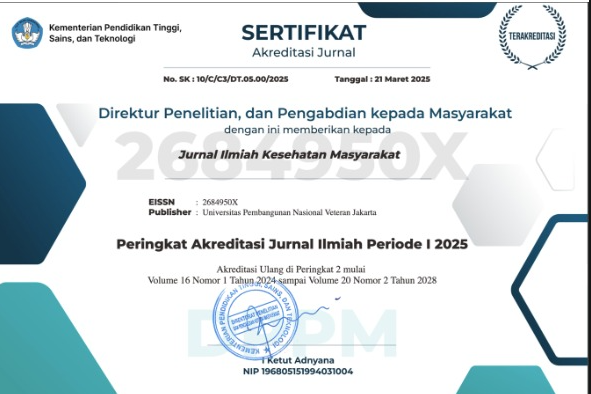Efektivitas Penggunaan Media Sosial dalam Pemasaran Rumah Sakit: Systematic Review
Abstract
Abstrak
Latar Belakang : Pada awal tahun 2020, jumlah pengguna media sosial di seluruh dunia telah melampaui angka 3,8 miliar. Banyak organisasi layanan kesehatan menggunakan media sosial. Pada tahun 2014, 94% rumah sakit menggunakan media sosial. Saat ini, jumlah rumah sakit yang menggunakan media sosial untuk komunikasi dan pemasaran semakin meningkat. Tujuan studi ini adalah untuk mengkaji penggunaan media sosial dalam bidang pemasaran di rumah sakit.
Metode: Kajian sistematis ini menggunakan metode PRISMA, mengkaji artikel yang dipublikasi tahun 2016 - 2020. Sumber artikel penelitian mengenai penggunaan media sosial dalam bidang pemasaran di rumah sakit didapatkan dengan pencarian menggunakan kata kunci “social media” dikombinasikan dengan kata kunci “hospital” dan “marketing" atau “hospital marketing” dan melalui database pencarian Google Scholar dan PubMed. Mendeley digunakan untuk menyusun dan mengevaluasi judul beserta abstrak, mengidentifikasi dan menghapus artikel yang ganda.
Hasil: Sebanyak 13 artikel dipilih untuk kajian sistematis. Hasilnya diklasifikasikan dan dilaporkan berdasarkan dua kategori, yaitu jenis platform dan efektivitasnya berupa manfaat dari penggunaannya. Jenis platform yang paling sering digunakan adalah Facebook kemudiaan diikuti dengan Twitter dan Instagram. Sedangkan manfaat terpenting adalah pengembangan strategi pemasaran (marketing) yang optimal.
Kesimpulan: Platform media sosial telah menjadi keharusan bagi suatu rumah sakit untuk pemasaran dan promosi saat ini serta mampu menciptakan brand image secara global terkait efektivitas penggunaannya yang dapat mempengaruhi reputasi rumah sakit.
Effectiveness of Use of Social Media Inmarketing Hospital: Systematic Review
Abstract
Background: At the beginning of 2020, the number of social media users worldwide has surpassed the 3.8 billion mark. Many health care organizations use social media. In 2014, 94% of hospitals used social media. Currently, the number of hospitals using social media for communication and marketing is increasing. The purpose of this study is to examine the use of social media in marketing in hospitals.
Methods: This systematic study uses the PRISMA method, reviewing articles published in 2016 - 2020. Sources of research articles on the use of social media in the field of marketing in hospitals are obtained by searching using the keyword “social media” combined with the keywords “hospital” and “marketing” or “hospital marketing. "And through the Google Scholar and PubMed search databases. Mendeley was used to compile and evaluate titles and abstracts, to identify and remove duplicate articles.
Results: A total of 13 articles were selected for a systematic review. The results are classified and reported based on two categories, namely the type of platform and its effectiveness in the form of benefits from its use. The type of platform most often used is Facebook followed by Twitter and Instagram. Meanwhile, the most important benefit is the development of an optimal marketing strategy.
Conclusion: Social media platforms have become a must for hospitals for marketing and promotion today and can create a global brand image regarding their effectiveness in use which can affect the hospital's reputation.
References
Sugawara Y, Murakami M, Narimatsu H. Use of Social Media by Hospitals and Clinics in Japan: Descriptive Study. JMIR Med Informatics. 2020;8(11):e18666.
MacDonald I. Hospitals embrace social media, but have yet to realize its full benefits | FierceHealthcare [Internet]. 2014 [cited 2020 Dec 31]. Available from: https://www.fiercehealthcare.com/healthcare/hospitals-embrace-social-media-but-have-yet-to-realize-its-full-benefits
Wong CA, Ostapovich G, Kramer-Golinkoff E, Griffis H, Asch DA, Merchant RM. How U.S. children’s hospitals use social media: A mixed methods study. Healthcare. 2016;4(1):15–21.
ÇERÇİ ÜÖ. Social Media Use of Hospitals in Terms of Communication and Public Relations. Turkish Online J Des Art Commun. 2017;7(2):192–202.
Arif UF, Darmawan ES. The Use of Social Media as Hospital Marketing. Proc Int Conf Appl Sci Heal. 2019;(4):902–8.
Smith KT. Hospital Marketing and Communications Via Social Media. Serv Mark Q [Internet]. 2017;38(3):187–201. Available from: https://doi.org/10.1080/15332969.2017.1363518
Triemstra JD, Poeppelman RS, Arora VM. Correlations between hospitals’ social media presence and reputation score and ranking: Cross-sectional analysis. J Med Internet Res. 2018;20(11):1–5.
John S, Larke R, Kilgour M. Applications of social media for medical tourism marketing: an empirical analysis. Anatolia [Internet]. 2018;29(4):553–65. Available from: https://doi.org/10.1080/13032917.2018.1473261
Yang PC, Lee WC, Liu HY, Shih MJ, Chen TJ, Chou LF, et al. Use of facebook by hospitals in taiwan: A nationwide survey. Int J Environ Res Public Health. 2018;15(6).
Bali S, Bélanger CH. Exploring the use of Facebook as a marketing and branding tool by hospital foundations. Int J Nonprofit Volunt Sect Mark. 2019;24(3):1–10.
Marliani L, Achadi A. The Effectiveness of Instagram as A Promotion Media at Citra Ananda Maternal and Child Health Hospital, Ciputat, Banten. 2019;130–6.
Yulhasmida, Yacob S, Lubis TA. Patients Visiting Intention: a Perspective of Internal and Social Media Marketing in Kambang Jambi Hospital. J Bus Stud Mangement Rev. 2019;2(2):143–53.
Aguerrebere PM. Twitter ’ s impact in building reputed hospital brands in USA. 2020;14:63–77.
İlgün G, Uğurluoğlu Ö. How Turkish Private Hospitals use Social media: A Qualitative Study. J Soc Serv Res. 2019;45(1):34–43.
Siswanto T. Optimalisasi Sosial Media sebagai Media Pemasaran Usaha Kecil Menengah. J Liq [Internet]. 2013 [cited 2020 Dec 31];2(1):80–6. Available from: http://www.ojs.itb-ad.ac.id/index.php/LQ/article/view/134









.jpg)








